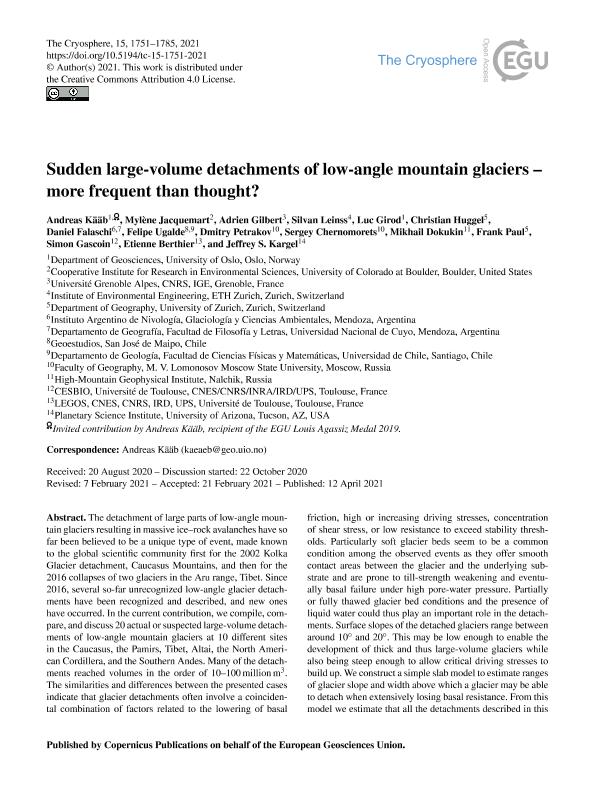Artículo
Sudden large-volume detachments of low-angle mountain glaciers - More frequent than thought?
Kääb, Andreas; Jacquemart, Mylène; Gilbert, Adrien; Leinss, Silvan; Girod, Luc; Huggel, Christian; Falaschi, Daniel ; Ugalde, Felipe; Petrakov, Dmitry; Chernomorets, Sergey; Dokukin, Mikhail; Paul, Frank; Gascoin, Simon; Berthier, Etienne; Kargel, Jeffrey S.
; Ugalde, Felipe; Petrakov, Dmitry; Chernomorets, Sergey; Dokukin, Mikhail; Paul, Frank; Gascoin, Simon; Berthier, Etienne; Kargel, Jeffrey S.
 ; Ugalde, Felipe; Petrakov, Dmitry; Chernomorets, Sergey; Dokukin, Mikhail; Paul, Frank; Gascoin, Simon; Berthier, Etienne; Kargel, Jeffrey S.
; Ugalde, Felipe; Petrakov, Dmitry; Chernomorets, Sergey; Dokukin, Mikhail; Paul, Frank; Gascoin, Simon; Berthier, Etienne; Kargel, Jeffrey S.
Fecha de publicación:
04/2021
Editorial:
Copernicus Publications
Revista:
Cryosphere
ISSN:
1994-0424
Idioma:
Inglés
Tipo de recurso:
Artículo publicado
Clasificación temática:
Resumen
The detachment of large parts of low-angle mountain glaciers resulting in massive ice-rock avalanches have so far been believed to be a unique type of event, made known to the global scientific community first for the 2002 Kolka Glacier detachment, Caucasus Mountains, and then for the 2016 collapses of two glaciers in the Aru range, Tibet. Since 2016, several so-far unrecognized low-angle glacier detachments have been recognized and described, and new ones have occurred. In the current contribution, we compile, compare, and discuss 20 actual or suspected large-volume detachments of low-angle mountain glaciers at 10 different sites in the Caucasus, the Pamirs, Tibet, Altai, the North American Cordillera, and the Southern Andes. Many of the detachments reached volumes in the order of 10-100 million 3. The similarities and differences between the presented cases indicate that glacier detachments often involve a coincidental combination of factors related to the lowering of basal friction, high or increasing driving stresses, concentration of shear stress, or low resistance to exceed stability thresholds. Particularly soft glacier beds seem to be a common condition among the observed events as they offer smooth contact areas between the glacier and the underlying substrate and are prone to till-strength weakening and eventually basal failure under high pore-water pressure. Partially or fully thawed glacier bed conditions and the presence of liquid water could thus play an important role in the detachments. Surface slopes of the detached glaciers range between around 10 and 20. This may be low enough to enable the development of thick and thus large-volume glaciers while also being steep enough to allow critical driving stresses to build up. We construct a simple slab model to estimate ranges of glacier slope and width above which a glacier may be able to detach when extensively losing basal resistance. From this model we estimate that all the detachments described in this page1752 study occurred due to a basal shear stress reduction of more than 50 %. Most of the ice-rock avalanches resulting from the detachments in this study have a particularly low angle of reach, down to around 5 g, likely due to their high ice content and connected liquefaction potential, the availability of soft basal slurries, and large amounts of basal water, as well as the smooth topographic setting typical for glacial valleys. Low-angle glacier detachments combine elements and likely also physical processes of glacier surges and ice break-offs from steep glaciers. The surge-like temporal evolution ahead of several detachments and their geographic proximity to other surge-type glaciers indicate the glacier detachments investigated can be interpreted as endmembers of the continuum of surge-like glacier instabilities. Though rare, glacier detachments appear to be more frequent than commonly thought and disclose, despite local differences in conditions and precursory evolutions, the fundamental and critical potential of low-angle soft glacier beds to fail catastrophically.
Palabras clave:
MOUNTAIN
,
GLACIER
,
ICE
Archivos asociados
Licencia
Identificadores
Colecciones
Articulos(IANIGLA)
Articulos de INST. ARG. DE NIVOLOGIA, GLACIOLOGIA Y CS. AMBIENT
Articulos de INST. ARG. DE NIVOLOGIA, GLACIOLOGIA Y CS. AMBIENT
Citación
Kääb, Andreas; Jacquemart, Mylène; Gilbert, Adrien; Leinss, Silvan; Girod, Luc; et al.; Sudden large-volume detachments of low-angle mountain glaciers - More frequent than thought?; Copernicus Publications; Cryosphere; 15; 4; 4-2021; 1751-1785
Compartir
Altmétricas



